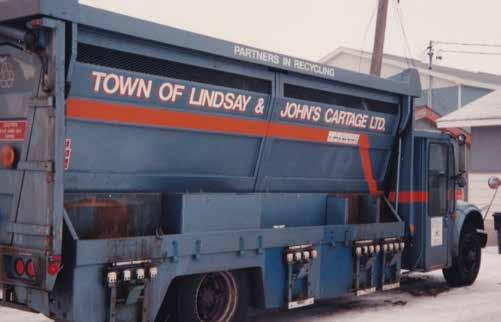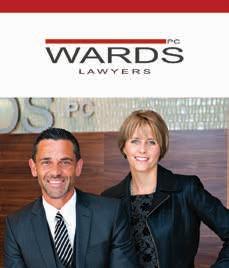
5 minute read
Just in Time
Waste Not, Want Not
Recycling and reusing in Kawartha Lakes
Advertisement
IAN McKECHNIE Writer-at-large
It’s a grey Thursday afternoon in late April as I sit down drive shaft was a treasure coveted and used over to write this column, a few hours after Miller Waste’s and over ... Unwanted field stones were piled up into chocolate brown and caramel-coloured garbage trucks useful walls; unmerchantable tree brush was burned have made their rounds through Lindsay and other com- to produce saleable potash. Ontario started without munities across the municipality. refuse, and with barely the concept of it.” (Entire build-
Stopping at the foot of driveways and laneways, the ings could be recycled: in 1888, red bricks previously orange-clad garbage collectors remove not only clear used in the Grand Trunk Railway’s Port Hope roundbags of refuse, but also the contents of our blue boxes. house were brought to Lindsay and used to build the These familiar plastic containers — distinguished by three engine sheds between Durham and Albert Streets.) white arrows arranged to look like they are in perpetual motion — brim over with our aluminum cans, our glass bottles and any number of plastic packaging materials. On alternate weeks, the Miller trucks collect fibrous materials — cardboard and newspaper — from similarly-sized green boxes. Once the boxes have been emptied, we return them to our garages or apartments and let them fill up again, knowing that we will be repeating the same ritual next week.
We call this process recycling, and while we may have a vague awareness of how it works and why it is important, we seldom think about how it came to be and just how sig- John’s Cartage began in 1963. Photo: Courtesy Al Hussey. nificant the blue box was when first introduced to this community a little over 30 years ago. The “reduce, reuse, recycle” concept persisted,
The intervening years, of course, have taught us that even though nobody used the word recycling. “Handrecycling is far from being a solution to our waste problem me-downs, pronounced to sound like one word, was a — a problem that’s entirely of our own modern creation. more common term,” observes historian Rae Fleming,
Of course, the concept of “reduce, reuse, recycle” has who grew up in the Argyle general store. “Sweaters been around for generations. went from one child to the next, and so on, until worn
University of Toronto emeritus professor Thomas out, but not thrown out. The yarn could be used to McIlwraithe, in his study Looking for Old Ontario, notes that knit socks, or for filling in quilts and so on. ‘Waste not, “In the farm-making era Ontarians recycled everything. want not,’ was a common expression well into the Every brick, skillet, spoon, pickle crock, millstone and second half of the 20th century.” 44

A quarter of a century after the end of the Second World War, circumstances had changed and a great deal of glass, metal, paper, and plastic was simply thrown out. Landfills were filling up, leading to widespread public conversation about the need for recycling by the 1980s.
That’s where Allen Hussey’s family enters the picture. “My stepfather, John Villeneuve, started John’s Cartage in 1963,” says Hussey, today the proprietor of The Bike Garage. “I started working for him in 1973, when I was 16.” They collected many loads of garbage from some of Lindsay’s larger industrial concerns, namely Uniroyal and Abex Industries, and hauled it all to the old landfill at the northernmost end of William Street.
Hussey purchased the company in 1988, and shortly thereafter heard rumours about the burgeoning recycling movement. Working with Trevor Lewis, then the engineer for Lindsay, and Don Barkey, Hussey’s business began a pilot project in which the town’s citizens were encouraged to leave their newspapers at the Lindsay fire hall where they would be picked up and taken to be recycled in the area’s first recycling plant on Hwy 35 south. “We had to build our own equipment back then to separate the co-mingled material (cans and plastics),” Hussey says. Cleats from rubber snowmobile tracks were used to perforate plastic pop bottles, thus making them easier to bale in preparation for shipment to processing facilities elsewhere in the province. A grassroots movement was developing. John’s Cartage worked with Judy Kearns and Emily town-
John’s Cartage worked ship reeve Ken Logan to establish with Judy Kearns and the Victoria Recycling Association,
Emily township reeve Ken Logan to establish and a blue box recycling program was launched in 1989 — the first in Lindsay and the fourth in Ontarthe Victoria Recycling io. “The public was really excited Association, and a blue about it,” Hussey remembers. Local box recycling program was launched in 1989 — citizens had been eagerly saving recyclable material for a couple of months beforehand, well aware that the first in Lindsay and they were making history by filling the fourth in Ontario. their blue boxes. Within a year, the program had expanded to include the villages of Bobcaygeon, Fenelon Falls, and Omemee, along with the townships of Eldon, Emily, Fenelon, Manvers, Ops and Verulam.
Said Hussey in a 1990 interview with the Lindsay Daily Post, “The blue box recycling program has made everyone aware of the serious problem we face with landfills.” He went on the speaking circuit, addressing local students in school assemblies about the importance of doing their bit. “I was the preacher of recycling back then,” he says. Two dozen schools across the Victoria County Board of Education formed Student Action for Recycling programs in 1990, and then-mayor Lorne Chester urged students to take the message of recycling home to their parents.
Over 30 years later, it is clear that the Victoria Recycling Association’s message transformed a community. Yet much remains to be done, and innovative solutions to our waste management challenges will no doubt continue to surprise and inspire us.

YOUR COMPLETE LEGAL TEAM
LITIGATION
BUSINESS & CORPORATE
FAMILY LAW
PERSONAL INJURY
COLLABORATIVE
REAL ESTATE
ESTATE PLANNING
LABOUR & EMPLOYMENT
WARDLEGAL.CA | 705-324-9273 84 KENT STREET WEST LINDSAY, ON









